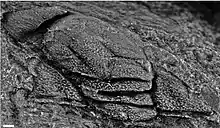Plutonides
Plutonides is a genus of Middle Cambrian trilobite in the family Paradoxididae with species Plutonia sedgwickii and possibly Plutonia? illingi. Several other species and subspecies were at times placed in Plutonides but have subsequently been moved to other genera.
| Plutonides | |
|---|---|
 | |
| Lectotype cranidium | |
| Scientific classification | |
| Kingdom: | Animalia |
| Phylum: | Arthropoda |
| Class: | †Trilobita |
| Order: | †Redlichiida |
| Family: | †Paradoxididae |
| Genus: | †Plutonides Hicks, 1895 |
| Type species | |
| Plutonia sedgwickii Hicks, 1871 | |
| Species | |
| |
| Synonyms | |
|
Plutonia Hicks, 1871,
| |
In terms of the Scandinavian Middle Cambrian sequence the genus ranges from the Baltoparadoxides oelandicus Biosuperzone (B. pinus Biosubzone) at the type locality on Trwyncynddeiriog headland located 1.3 km (0.81 mi) south-southwest of St David’s Cathedral and 500 m (1,600 ft) east of Porth Clais Harbour - Pen-y-Cyfrwy Member, Newgale Formation,[1] and possibly to middle part of the Mawddachites hicksii Biozone on the Penpleidiau (eastern) Headland of Caerfai Bay south of St David’s in southwest Wales, Locs. TC-1 & CF-1 of Rees et al.[1]
Type
Plutonia sedgwickii is the type species for the genus[2] and was first described in 1871 as "Plutonia" sedgwickii. However the genus name "Plutonia" had already been used for the Vitrinidae snail genus Plutonia by Morelet (1864), and so the new genus Plutonides was coined by Hicks (1895).[3] The species Lectotype is SM A1086, an internal mould of cranidium, [4][5].[1][6]
Species
Paradoxides cf. sedgwickii, described by Smith and White (1963) from the Baltoparadoxides pinus Biosubzone in the upper part of the Purley Shale Formation of Warwickshire, central England[6] was redescribed by Rushton (1966, p. 42, pl. 6, figs. 1-10) [7] as ‘Paradoxides’ sedgwickii porphyrus. The subspecies has broader palpebral lobes and finer surface granulation than seen in other P. sedgwickii subspecies.
Vanĕk et al. (1999) described cranidia from the Middle Cambrian of Skrije - Týřovice area in the Czech Republic as Plutonides hicksi.[8] Fletcher (2007) however, established a new subgenus, Paradoxides (Mawddachites), to include P. hicksii as type species.[9] Alvarez et al. (2010) raised Mawddachites to a full genus.[10][11]
References
- Rees, A. J.; Thomas, A. T.; Lewis, M.; Hughes, H. E.; Turner, P (2014). "The Cambrian of SW Wales: Towards a United Avalonian Stratigraphy". Geological Society, London, Memoirs. 42: 1–31. doi:10.1144/M42.1. S2CID 130386389.
- Harkness, R.; Hicks, H (1871). "On the ancient rocks of the St David's Promontory, South Wales, and their fossil contents: with descriptions of the new species, by H. Hicks, Esq". Quarterly Journal of the Geological Society, London. 27 (1–2): 384–404. doi:10.1144/GSL.JGS.1871.027.01-02.46. S2CID 128467392.
- Hicks, H. (1895). "On the genus Plutonides (non Plutonia) from the Cambrian rocks of St. David's". Geological Magazine. Decade 4 (2): 230–231. Bibcode:1895GeoM....2..230H. doi:10.1017/S0016756800121193.
- Morris, S. F. (1988). "A Review of British Trilobites, Including a Synoptic Revision of Salter's Monograph". Monograph of the Palaeontographical Society, London. 140 (374): 1–316.
- Lake, P. (1935). "A Monograph of the British Cambrian Trilobites". Monograph of the Palaeontographical Society, London: 197–224, pls. 26–31, pl. 31, fig. 9. doi:10.1080/02693445.1935.12035634.
- Smith, J.D.D.; White, D.E. (1963). "Cambrian trilobites from the Purley Shales of Warwickshire". Palaeontology. 6: 397–407, pl. 58, fig. 9.
- Rushton1966, A. W. A. (1966). "The Cambrian Trilobites from the Purley Shales of Warwickshire". Monograph of the Palaeontographical Society, London. 120 (511).
- Vanĕk, J; Valiček, J.; Vocáč, V. (1999). "Plutonides hicksi (Salter) from the Middle Cambrian of Skrije - Týřovice Area (Czech Republic)" (PDF). Palaeontologica Bohemiae. 6: 36–38. Retrieved 2015-01-04.
- Fletcher, T. P. (2007). "Correlating the zones of "Paradoxides hicksii" and "Paradoxides davidis" in Cambrian Series 3". Memoirs of the Association of Australasian Palaeontologists. 33: 35–56.
- Dies Alvares, M. E.; Rushton, A. W. A.; Gozalao, R.; Pillola, G. L.; Liñan, E.; Ahlberg, P. (2010). "Paradoxides brachyrhachis Linnarsson, 1883 versus Paradoxides mediterraneus Pompeckj, 1901: a problematic determination". GFF. 132 (2, June): 95–104. doi:10.1080/11035897.2010.481363. ISSN 1103-5897. S2CID 129620469.
- "Plutonides hicksi (Salter, 1864)". Trilobiti - Barrandien. Retrieved 2015-01-04.